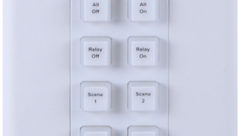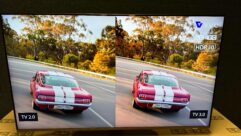
Technology Showcase:
DVRs and Beyond
Oct 1, 2005 12:00 PM,
By Bret Bass
All eyes on IP surveillance.
Pelco DX8000 DVR
When considering the largest existing market opportunity for video surveillance systems, J.P. Freeman Co., a leading security industry research firm, stands by its assessment that the United States will continue to support the most growth. “If you want to make the biggest splash, you go into the U.S. market,” Freeman says. However, it’s equally important to consider the European market, which virtually pioneered the concept and systems used around the world today.
The United Kingdom leads the world in video surveillance with more public areas under observation than in any other country. London is estimated to have approximately 500,000 cameras throughout the city, according to a Wall Street Journal report. The report supposes that a single person can expect to be filmed at least 300 times a day. Analysts believe the total camera population throughout the United Kingdom to settle somewhere around 7 million.
The industry’s first direct network-attached digital color camera for Internet/intranet systems, the Axis 200, also hailed from Europe. Although the United States may offer the greatest market opportunities, the manufacturers and integrators abroad repeatedly shape the direction of the industry, even when choosing American-made products. For that reason, we will focus on those products the European experts are touting.
TOP TWO INNOVATIVE DVRS
Pelco products have a long-standing reputation as video surveillance technology leaders, due in large part to their quality, longevity, and durability, but the Pelco DX8000 takes durability to a new level. The unit appears impregnable and designed to withstand any natural or man-made peril. Where most DVRs weigh in around 22lbs., this heavy hitter steps into the ring just under 44lbs. It is the DX8000’s technical attributes, however, that propel it beyond its peers.
The unit offers a maximum resolution of 720×576 pixels and a top recording rate of 400 images per second. The standard unit comes equipped with 16 camera inputs and a 80GB hard drive, expandable to 1TB. Depending on the number of connected cameras, the resolution selected, and compression and frame rate settings, archive-recording times can be measured in weeks or months, instead of mere days.
Images can be backed up and exported to optical discs using the CD-RW drive. Its well-conceived networking capabilities allow images and motion-based alerts to be sent, via network or Internet, to remote PCs and handheld devices.

Vivid DVR
Although DVR manufacturers have been including bi-directional audio capabilities in units with increasing frequency, most are limited to one or two channels. The DX8000 family provides one audio recording channel for each camera input. While this is impressive in terms of audio recording, the system is not designed for bi-directional audio, which is desirable when considering remote monitoring and management options.
The DX8000 uses the Windows 2000 Professional operating system. Following boot up, the video application automatically launches in live viewing mode and begins recording. The design team at Pelco appears to have spent a lot of energy in ensuring an intuitive and user-friendly application, with easily navigated timeline displays, graphical recording progress representations, alarm and motion events, and a bar graph that indicates total disk usage.
The search features perform in one of three ways, providing users with options that best suit their preferences. The index search generates a list of alarm- and motion-activated events, and the thumbnail search displays the first image from the start of each new recording. The pixel search allows a user to specify and target an area of interest in a recording, displaying all video data relevant to the images recorded in the past 24 hours where movement has occurred in the selected area. I found this particular search feature to offer the most advantages in detecting and retrieving critical data. The only other comparable search feature I have used and appreciated can be found in the Eastman Telebell ETZ and ETS products.
Backup options on the device are also noteworthy, as the DX8000 offers users the choice between CD-RW, DVD-RW, external tape, or external network drives. Archive recordings can be exported using the unit’s native format or through a variety of other standard formats, including AVI, ASF, BMP, JPEG, or TIFF. When attempting to send video data to third parties, such as the police, many units fall short because they can’t export video clips in universally playable formats. The Pelco DX8000 overcomes this irritating obstacle.
Playback control on the Pelco is excellent. The ability to quickly locate events from the timeline or search menus puts many rival products to shame. Moreover, the unit offers exceptional reviewing quality using its fast search mode or slow motion mode for more intensive discrimination. The DX8000 provides comprehensive monitoring and recording options for a wide range of installations, with a tremendous scope for expansion, access, and control.
With the vast number of DVR manufacturers flooding the industry, even those companies with established brands (Dedicated Micros, GE Interlogix, Honeywell) are facing the ongoing challenge of how to survive and are creating new innovations in product lines to fend off the competition. Smaller companies are aggressively vying for market position and the top dogs are treading on less stable footing than in years past. One thing is certain: The manufacturers with the most progressive R&D departments will successfully stem the tide and best their competition. Baxall is striving to be such a company.
Currently, Baxall offers three models — entry-level, mid-level, and high-end. They are, respectively, the Vivid Lite, the Vivid, and the Vivid Plus. The mid-range model is the most common and offers a choice of 6, 10, or 16 input channels and hard disk drives from 80GB to 1TB. The machines also offer audio capabilities, an increasingly common feature in DVRs seeking to compete in the industry. On the surface, the units appear not too dissimilar from many others, but they all boast one significant difference that is manifested in the unique compression technology.

Axis NVR
JPEG 2000 compression is a key feature of these DVRs. At higher compression levels, these DVRs improve efficiency and offers better image quality. The JPEG 2000 also provides a 30 percent increase in recording time for a given amount of storage space. This technology moves away from the standard Discreet Consine Transformation (DCT) algorithm that breaks down data into segments, which often results in “block” pixilation during rapid movement. Instead, this unit relies on Wavelet Transform algorithms, which encode image data in a continuous stream, thereby reducing the impact of blocking. When such incidents occur, which is rare, the algorithm causes blurring in areas of fine detail, which only degrade the video by softening its appearance as opposed to distorting it.
Other features on this unit include a front-mounted USB socket to download images or recordings onto portable memory modules, copy configuration settings in multiple DVR installations, download software upgrades, or to connect peripheral USB devices, such as keyboards. The embedded version of the Linux operating system, renown for its stability, safety, and performance, fuels the system.
The Vivid DVR provides great image quality and some incredibly long recording times. It presents users with a choice of linear, looping, or event-based recording modes. The resolution comes in a maximum of 720×288 pixels in a variety of single- or multi-screen display formats, including picture-in-picture and picture zoom.
A 19in. rack-mountable case, with aesthetically pleasing control placement and design, houses the unit. Yet, another advantage for installation technicians is that the Baxall units are ready to go right out of the box; they are automatically optimized and preset for a 31-day recording schedule. But taking the pain out of the installation compares only to the ease with which users can control the unit through the robust simplicity of the viewing interface.
The Vivid’s exceptional playback quality also pushes the envelope, giving competitors a run for their money. When using the highest picture detail value (60kb), contrast balance and color rendition are virtually indistinguishable from a live camera feed. Even in the multiple-camera viewing modes, images shine with clarity and fluidity of movement. Search functions in the unit are standard: date-and-time search or event search, but they are functionally sound and straightforward. The unit’s performance is also sound enough that there’s little need to use the highest compression levels; on lower settings, the machine will continue to put forth picture and sound quality as good as, if not better than, rival devices.
OTHER CONTENDERS
MEL Secure Systems is launching a fleet of new DVRs, ranging from one to eight cameras. The recorders use high-performance H.264 compression technology, which broadcasts television-quality images at around 20 percent of the cost of other systems. With a standard 1.5TB hard disk drive, the unit can store up to 30 days of video from all cameras, recording in realtime at 720×540.
The new Sony HSR-J2009 and HSR-J2016 have A/D conversion capabilities and support an intriguing Region-of-Interest (ROI) function, which improves the quality of a set area targeted for motion detection. When a user specifies an area to observe for motion violations, the unit records and displays the image in clear, high quality while lowering the quality of the surrounding screen regions. This enables desired images to be recorded with superior quality, in a sufficient amount of screen space, but at smaller file sizes, thereby increasing storage performance and archive times.
NETWORK VIDEO RECORDERS
If the automotive industry progressed as fast as the computer industry, some argue that factories would be churning out vehicles flaunting 200 miles-per-gallon fuel consumption rates. Comparatively speaking, however, the computer industry moves at immeasurable velocity, and though DVRs have just recently situated themselves as a surveillance standard, some manufacturing stalwarts are already anticipating their demise. Teldat Security and Axis Communications are both heralding the nascent but inevitable domination of Network Video Recorders (NVRs).
Instead of saving images on hard disk drives locally, as DVRs operate, NVRs are video transmission devices that send information to large file servers and centrally located management systems. Currently, the applications for these systems are large and deployed in such environments as educational institutions and corporations that are locally capable of high-speed bandwidth. But as the price of bandwidth decreases, this storage option becomes more efficient, manageable, and cost effective than a local storage device.
Axis Communications, the founding father of network video, has inaugurated another groundbreaking product: the Axis 262 NVR. The system currently hosts a maximum of eight Axis network cameras, or eight Axis video servers with up to eight analog cameras. The products aim to support small- to medium-sized and multi-site businesses where bandwidth limitations across a wide area network exist. Axis envisions receptive markets to include franchise retail businesses, service stations, hotels, and networked offices.
Remote viewing and playback are still facilitated through an integrated web-based server, but the 262 NVR also allows users to extract data from the built-in 160GB hard disk drive of any local PC, in order to save images to CD-R or DVD media.

DVMRE
Further championing the Axis product is the company’s strategic alliance with DVTel’s Latitude Network Video Management System (NVMS). The Latitude NVMS, a software-based enterprise level video, audio, and data management system, seamlessly ties in with Axis’ next-generation line of network cameras and video servers. Users control all monitoring, recording, playback, and data analyses through a single graphical user interface (GUI) to react to security threats.
SENTIENT MACHINES
Speculative fiction fans have long imagined a world where computers think independently, make conscious decisions, embrace paranoia with unthinkable rapidity, and destroy humankind for its own protection. But it wasn’t until the 1980s, when a rules-based AI computer asked its programmer, “Am I alive?” that the concept of sentient computers verged on tangible reality. Although computers, much less DVRs, are not yet sentient or bent on new world order, they get smarter everyday. So too do the new behavior-detecting surveillance products dawning on the market.
Cernium Perceptrak is a veteran to the industry, but it is steadily gaining momentum with its inventive behavior recognition and intelligent video analysis software. Using advanced scenario algorithms, the software detects up to 16 events, including erratic human behaviors, lurching automobiles, abandoned objects, and wrong-way motion. With a single GUI, an operator can administer hundreds of cameras, effectively detecting and processing events. When the Perceptrak system perceives suspicious activity, it isolates the event and alerts operators, who then observe the incident further. Ideologically, the system provides a preemptive alert to a crime before it has occurred.
In addition to the recognition component, the system offers all the functionality of a standard, high-end DVR. Cernium’s products have garnered enough attention in the industry to win large contracts with Johns Hopkins University, the Federal Aviation Administration, and the Transportation Security Administration.
GE is also promoting a new human detection DVR, which helps security teams identify potential threats with greater speed and accuracy and minimize false alarms caused by non-human movement. VideoIQ shows both alarm violations and the corresponding video footage, and it works well in outdoor environments, where monitoring presents difficult challenges.
The system is PC-based and supports eight cameras. Although the system does not specifically recognize and evaluate behaviors like the Cernium product, it does effectively separate objects from a camera image into foreground and background elements. After isolating the images, VideoIQ ignores the dynamic background motion generated by swaying tree branches, rippling water, and other environmental causes. The end result is a unit able to distinguish one object from another, using a database of learned object characteristics. The unit continuously learns object behaviors, and works well even in such adverse conditions as poor lighting, inclement weather, and poor-quality video sources. This feature assists operators in determining false alarms from actual emergencies.
The unit operates in standalone mode, or it can be integrated into one of GE’s existing DVMRe DVR products. The VideoIQ machine comes stocked with a 3.2GHz CPU, 512MB of RAM, 80GB hard disk drive, floppy and CD-ROM drives, and a Windows XP Professional operating system.
BACK TO BASICS
Even with the influx of new innovations in DVR products, the old favorites have not lost interest with installers and integrators. These tried-and-true products continue to dominate industry market share as a result of familiarity, established performance, reputation, and price. However, as some of the newer products explored in this article continue to gain ground, along with the continuing affordability of more innovative technologies and user sophistication, they may soon replace the old standards. In the end, every integrator knows price alone is not always a competitive advantage, especially in lieu of consumers’ growing security needs.
This article has explored the burgeoning product lines that offer the latest technological advances in DVR functionality and design, but the standards continue to remain excellent for the everyday integrators and their customers. According to two of the security industry’s leading product distributors, ADI and Tri-Ed, these best sellers top the list: ADI, Dedicated Micros, Honeywell Rapid Eye, Digimerge, Speco Technologies, Tri-Ed, Digital Logic America, Samsung, and EverFocus.
When considering any product, integrators should focus more on performance and functionality than on price alone. One of the key considerations is compression and images per second. Compression and frame-rate technologies can be confusing and differ as much as the products themselves, but sticking with the basics is always the best bet.
The human eye retains the impression of an observed object on the retina for about 40 milliseconds, which equates to 1/25 of a second. In realtime, this means images need to be displayed at 25 pictures per second to appear natural, without flickering or skipping. If the product you are considering does not instantly meet this criterion, it’s not worth further consideration.
When considering compression, ensure that the unit records data with clarity and longevity using the onboard components. If a product requires costly hard drive additions to accomplish the task, it may not be worth your while.
For More Information
Axis
www.axis.com
Baxall
www.baxall.com
Cernium
www.cernium.com
Dedicated Micros
www.dedicatedmicros.com
Digimerge
www.digimerge.com
DVTel
www.dvtel.com
EverFocus
www.everfocus.com
Honeywell
www.honeywell.com
MEL Security Systems
www.enforceronline.com
Pelco
www.pelco.com
Samsung
www.samsung.com
Sony
www.sony.com
Speco Technologies
www.specotech.com
Tri-Ed
www.tri-ed.com










